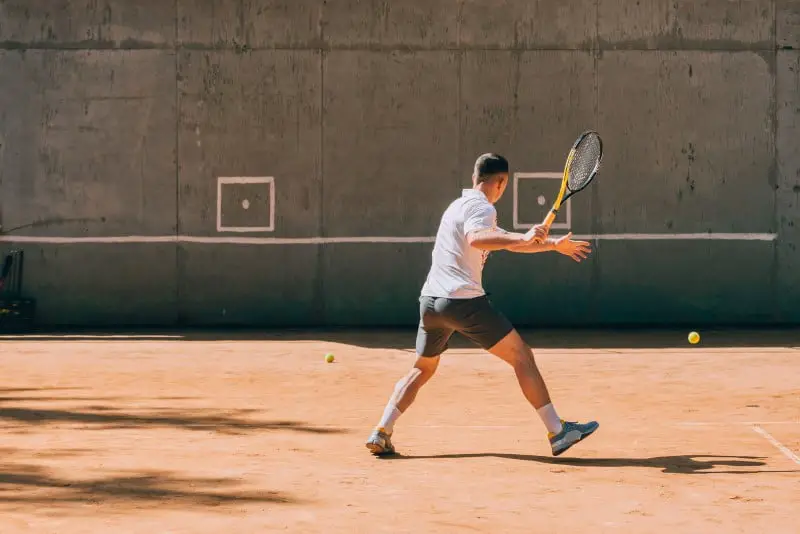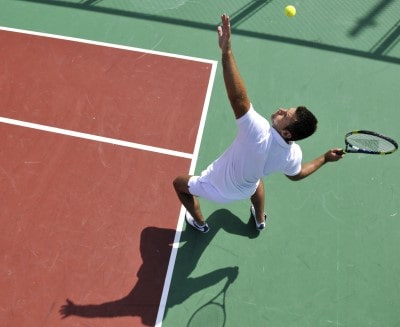If you happen to not have a training buddy but are still interested in getting as much practice in as possible, then there are several options you can choose from. The two most common ways to practice alone are on a wall and with a tennis ball machine.
However, many tennis players are faced with one question, namely, what is the difference between a tennis ball machine and a wall. Both the tennis ball machine and the wall are excellent ways to practice tennis alone. You can work on your footing, placement, and technique on both. However, a tennis ball machine is better in offering a more realistic ball movement and feel for the tennis court compared to a wall.
In this article, I explain in more detail how the tennis ball machine and the wall may affect your practice sessions and what you can expect from each one.
For a more in-depth look at the differences and the pros and cons of each training method, continue reading below.

Consistency
With a ball machine, you will have certain advantages that cannot be replicated while practicing on a wall or even with a partner, namely—the very precise shots. A ball machine can be used to make the same shot for an unlimited amount of times.
The advantage you get from these consistent shots is being able to practice and work on specific areas that you feel like need improvement. In other words, you can practice the same shot for as long as you like to.
Real Game Carryover
This is one of the aspects where wall practice lacks compared to training with a tennis ball machine.
Earlier I said that you could practice all the shots that you will be doing in a real match, however, doing a serve on a wall is very tricky as it is difficult to get a good feel of the depth and placement of the ball.
Full swings and hard hits are usually a no-no when it comes to hitting against a wall. The ball will just return very quickly back to you.
You can also practice doing spin shots. However, the ball will be coming back off the wall with very little to no spin making it extremely difficult to learn how to play spin shots.
While in comparison, a tennis ball machine can give the ball a very realistic spin (frequently, the amount of spin can be adjusted, too).
On a wall, you will be having a lot harder time practicing your placement shots while with a ball machine, this is a lot more doable.
With a wall, you lack the depth of the court. This is an important part of tennis as depth control and placement are some of the most fundamental skills you need to work on.
Most tennis players chose to play on two bounces when practicing on a wall for a more realistic experience, but a fact is a fact, and a wall will never be the same as playing on a real-size court.
Alternatively, a tennis ball machine produces a significantly more realistic feel and play. They can follow different patterns and timing and produce realistic spin.
Availability
One of the problems a lot of the new tennis players can stumble upon is the simple fact that not everyone may have access to a tennis ball machine. Or additionally, not everyone may be able to afford to rent one day in and day out.
A tennis ball machine is an excellent way to work on your form and game, but you need to understand how to use it properly. In other words, you need to have a goal and understand how to reach it.
You will have to adjust the frequency, the height, and the speed of the machine.
Footwork
Hitting on the wall is great for working on your footwork.
However, it can also be detrimental to your footwork if you stick to hitting the ball straight to yourself. Since there is no real opponent in front of them, a lot of tennis players will just stand in one place and not move at all.
A tennis ball machine can also be used quite successfully for working on one’s footwork. Thanks to the consistency of the balls, you can work very effectively on your footwork, especially when using tennis ball machines with oscillation.
Fitness and Cardio
Both the wall and the tennis ball machine are great for developing your overall fitness level.
A wall may be stationary, and thus underestimated, but it can do for an excellent workout that will improve your fitness, stamina, endurance, and cardio.
Tennis ball machines, on the other hand, can be adjusted according to your personal goals and level as it offers a lot of different features.
Solo Practice
We all know that everyone is up for a match, but not a lot of people will agree to a practice session.
Hitting against a wall can be a great way to practice alone if you do not have a training partner or cannot afford a tennis ball machine or practicing lessons with a coach.
Even better, all you need to get a little practice in is a wall—nothing more, nothing less.
If you have no one to play with and practice a ball machine can also be an excellent alternative. In fact, it is hands down one of the best ways to practice alone. Read our full article on How To Practice Tennis At Home Alone.
Technique Improvement
One of the frequent questions some players have is whether or not hitting on the wall is a good practice.
Hitting on a wall, I admit, can be seen as a little boring.
However, I consider walls to be one of the most underestimated and frequently overlooked ways to practice.
Practicing on a wall is great for working on and developing your consistency and stroke mechanics. In fact, a wall is an excellent tool that you can use to practice and work on every shot you will hit in a match.
While hitting on a wall, you can practice your forehand and backhand, slashes, high, low, half, and swing volleys, overheads, and even approach shots.
Compared to a machine, a wall is better for working on your reflexes.
Another advantage of a wall is the huge amount of training volume you can put in, in just a few minutes of training.
A brief wall practice can also be a neat and easy way to fine-tune the balance and weight of your racquet setup.
A tennis ball machine can undoubtedly offer a lot more when it comes to working on your technique.
Suitability
Wall practice is perfect for beginners as it can help any new tennis player work and develop their reflexes and technique in a non-demanding, non-stressful way.
However, the more experienced the player, the fewer advantages there will be for them from playing on a wall.
For more experienced players wall practice can be useful for testing new techniques and brushing up on some mistakes and fundamentals.
Don’t get me wrong. Experienced tennis players can still benefit from hitting on a wall, but to a lesser extent. This is why advanced players usually prefer to practice on a tennis ball machine as it offers more realistic experience and variations.
Focus
Both the wall and the tennis ball machine require high levels of concentration and consistency. Practicing one hour on either one is not going to do much for you; if you want to really improve your tennis game, you need to start practicing over a long period of time in a very consistent and organized manner.
When you practice on a wall, you should not hit the ball aimlessly. The same holds true for the tennis ball machine, too.
You need a plan in order to get the best from your practice sessions.
With a wall, it may be a little difficult to imagine you are playing on a real tennis court.
At first, it may be a little hard to adapt to the change in scenery, so to speak, the depth and feel are just not there, which is not the case with a tennis ball machine.
It is also worth mentioning that some tennis players can get easily bored practicing on a wall, which could affect their focus, form, and overall technique.
Price
There are no two opinions here. A wall is definitely going to be easier on your wallet. Some players even practice against their garage doors.
A tennis ball machine, however, can be an expensive venture. You can read more about The Best Tennis Ball Machines.
Injury Recovery
Both wall practice and tennis ball machines can be used quite successfully for building up the strength after injuries.
Tennis players suffering from tennis elbow will find that hitting on a wall is an excellent low-impact and non-demanding way to put in some practice and strengthen up their elbows and ligaments in that area, including improving your forearm and wrist stability.


